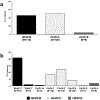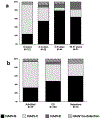Human adenovirus species in children with acute respiratory illnesses
- PMID: 33360858
- PMCID: PMC8324062
- DOI: 10.1016/j.jcv.2020.104716
Human adenovirus species in children with acute respiratory illnesses
Abstract
Background: Human adenovirus (HAdV) species B, C, and E are commonly associated with acute respiratory illnesses (ARI). We sought to determine the association between HAdV species and ARI severity in children over one respiratory season at Monroe Carell Jr. Children's Hospital at Vanderbilt.
Methods: We conducted a retrospective cohort study of children with HAdV from a provider-ordered BioFire® FilmArray Respiratory Pathogen Panel 2.0 (RPP) from 05/2018-06/2019. Type-specific PCR assays for HAdV-B3, B7, B11, B14, B16, B21, HAdV-C1, C2, C5, C6, and HAdV-E4 were performed. Demographics, clinical characteristics, and outcome data were compared between HAdV species.
Results: Of 4514 respiratory specimens collected, 2644 (59 %) had at least one pathogen detected by RPP, and 384 (15 %) were HAdV-positive; 342 (89 %) were available for research testing with 306 (89 %) specimens from unique symptomatic individuals; 237 (77 %) were positive for the following species: 104 (44 %) HAdV-B, 114 (48 %) HAdV-C, 9 (4%) HAdV-E, and 10 (4%) with co-detection between species. The majority with identified HAdV species were seen in the ED (62 %), and approximately one-third were hospitalized. Patients with HAdV-C were more likely to be younger, hospitalized, and have a higher frequency of seizures compared to HAdV-B.
Conclusion: HAdV-C and HAdV-B were the most common species detected, with differences in clinical characteristics and outcomes noted. Additional studies with larger sample sizes focusing on a high-risk pediatric population are necessary to determine if differences in illness severity across individual HAdV types exist to guide further type-specific HAdV vaccine development.
Keywords: Adenovirus; Epidemiology; Respiratory; Species.
Copyright © 2020 Elsevier B.V. All rights reserved.
Figures




References
-
- Tam CC, et al., Changes in causes of acute gastroenteritis in the United Kingdom over 15 years: microbiologic findings from 2 prospective, population-based studies of infectious intestinal disease, Clin. Infect. Dis 54 (9) (2012) 1275–1286. - PubMed
-
- Edwards KM, et al., Adenovirus infections in young children, Pediatrics 76 (3) (1985) 420–424. - PubMed
Publication types
MeSH terms
Grants and funding
LinkOut - more resources
Full Text Sources
Other Literature Sources
Miscellaneous

